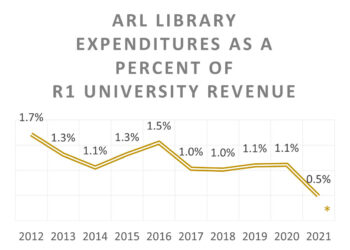
We have heard the first part of this story before, but it bears repeating:
Professional societies began their publishing ventures as a means for members to share their work with other like-minded individuals. Typically, members of a society paid a fee or dues, and among the benefits of membership was free or discounted access to the society’s publication. Non-members, including institutions, paid a subscription fee for the journal, which ultimately gave rise to the situation we have today, where academic libraries’ subscriptions vastly outstrip membership dues as a source of revenue for societies. When journals became digital and libraries granted remote access to authorized users, many society members stopped paying their membership dues because the journal was now available to them at no cost to them. While societies provide other benefits to members (discounted conference fees, policy work with government officials, public education), many societies today are facing a difficult problem of coming up with benefits that their members are willing to pay for. (I elaborated on this theme in a presentation for Oxford University Press last summer and published the text of that presentation on the Scholarly Kitchen.)
That’s the old face of the professional society — assemble a group of like-minded individuals and then develop a publishing program to cement their affiliation. The new face of the professional society may work in the opposite direction, beginning with publication and then forming bonds around the publishing service. Let’s extrapolate a bit from current activity in scholarly communications to see how this could develop.
The watershed event in scholarly communications in recent years was the launch and success of PLoS ONE. It is our iPhone, our Kindle: it remade the environment overnight and demands a recalculation of every organization’s strategy. Although I think PLoS ONE faces significant challenges ahead because of its unsustainably high pricing, the author-pays model it developed and mastered is being copied everywhere. There are predictions, which I don’t share, that in time all academic publishing will be modeled on PLoS ONE, but at a minimum it has to said that the author-pays model will be a significant component of scholarly communications for many years to come.
Is PLoS ONE a service for like-minded individuals? Not really. Although certain domains are more active than others (life scientists may find a home here, but Chaucer scholars are not invited), PLoS ONE is a supermarket, a “horizontal” publication serving science as a whole. This doesn’t mean that the contributors don’t share many views, but the common element of PLoS ONE is a matter of business — the Gold OA model.
Some of the organizations that are imitating PLoS ONE are doing so more vertically; they are identifying specific domains and inviting authors to submit papers (e.g., “ChemistryOpen” from John Wiley). We can imagine an environment where every discipline or subdiscipline of any size has its own author-pays service. Some of these services will be branded with the name of an established publisher or institution, some will be upstarts, and some will be labelled as “predatory” publishers because of the limitations of their peer-review practices.
How long will it be before these domain-specific author-pays services evolve into proto-professional societies? That may be part of the inspiration for PeerJ, which is set up with a membership model, but PeerJ (which, of course, is just starting out and may switch direction many times before it finds its way, as most successful start-ups do) still seems to be looking for a horizontal play, attempting to bring in material across a wide area (from the Web site: “PeerJ is a rapid, peer-reviewed, Open Access journal in the Biological and Medical Sciences”). In any event, by switching to a membership model and very low pricing (lifetime membership for $99), PeerJ is a repudiation of the strategy of PLoS ONE. As one of the founders of PeerJ, Dr. Peter Binfield, was formerly responsible for PLoS ONE, one imagines that the PLoS board is doing some hard thinking about where things are headed.
We should look for new services to come on stream that pluck the best from PLoS ONE, the ambitions of PeerJ, and the demonstrable successes of professional society publishing. Some characteristics of such a service are likely to include the following:
- A commitment to the Gold OA author-pays model of PLoS ONE, including the use of “peer-review light,” that is, a form of peer review that assesses methodology but does not speak to importance or originality.
- An incorporation of the membership model of PeerJ, in effect turning the fee associated with Gold OA into the dues for a professional society.
- The introduction of a suite of premium services designed to increase the size of payments from the new members.
- The launch of a conference business, which is likely to resemble in many respects the conference businesses now managed by hundreds of professional societies.
- A steady teasing-out of new ways to monetize the membership.
This last item points to the inherent limitation of any author-pays service — namely, whereas traditional publishers seek to monetize content, Gold OA publishers seek to monetize authors. It’s asymmetrical: there are more readers in the world than authors, even for highly specialized scholarly material. Traditional publishing spreads the cost of publication across the reader base; Gold OA spreads the cost to no one — it is borne entirely by the author or the author’s sponsor. This is why I don’t think traditional publishing is going away anytime soon, as its economic model enables greater income, which in turn can be invested in new features and more robust platforms.
Publishers working with a traditional model, whether commercial publishers or professional societies, should be thinking about the possibility of creating new domain-specific scholarly communities around open access services. It’s a strategic mistake not to explore these areas, as someone else certainly will. It is not unrealistic to imagine that many future professional societies will in fact be “owned” by commercial organizations. The key, as it always is, is management — the winner has the vision and the determination.
Discussion
22 Thoughts on "The New Face of the Professional Society"
A membership model for author pays is an inviting concept but it seems to require that authors not publish in a variety of journals, which is the present practice. Researchers tend to be nomadic in that they explore lots of approaches to the question they are working on and different approaches lead to different journals. So do different aspects of their work such as methods, results and implications.
This nomadic aspect is a striking feature of many author’s publication histories. It also helps explain why there are so many different journals, as a single research program can have many facets. The concept of membership seems more agrarian than nomadic, as it were, and science is nomadic because it is exploratory.
Moreover, what you describe as a future environment where every discipline or subdiscipline of any size has its own author-pays service already exists, especially in the so-called predatory publishers. (These are really low budget broad spectrum operations. “Predatory” is just a slur. In some cases they are the publishers of last resort which is the very opposite of predation.) These publishers run hundreds of journals, subdividing STM in various ways.
Then too PeerJ is an unsustainable joke at this point, promising to publish an article a year for life for $99. No journal can publish 10, 20 or 30 articles with a total income of $99. It is impossible. The business plan is simply hidden and for all we know the article fee will surpass PLoSONE when the cards are finally laid face up.
This does not mean a membership approach to author pays cannot work, but it will not be easy. Conferences may be the key, especially highly focused e-conferences or some other magic. But you are selling to nomads with special needs.
The business model of PeerJ is not entirely hidden. They charge $99 PER AUTHOR. Most papers these days have many authors. So let’s say you have 10 authors – that is $990. They still can’t publish 20 or 30 papers on $990. But then membership is only “for life” if you review every year for PeerJ. I’m sure they’ve run the numbers and figured out how many people are likely to do this, vs just pay another $99 (plus co-authors) next year. It still doesn’t entirely add up but one can begin to see how a viable business model might emerge with some additional services/fee thrown in.
To be clear though, it remains unknown what is meant by, “contribute one review to our community every 12 months.” Is this a full peer review of a paper, a comment left post publication, etc? We had asked this of someone from PeerJ in the comments of one of our articles, and never received a response to the question of whether leaving a comment on a paper that said, “Nice paper,” would count as a review. If that’s the case, I suspect you’ll see lots of authors doing something like that once a year.
I may have missed something! If I am a member and want them to publish my paper do they require that every co-author also be a member? I missed that in the fine print. That is a huge restriction. Am I supposed to beg/invite my co-authors to join so I can get my membership benefit? Now it looks like a pyramid scheme. Fascinating.
The proposition that a Society is based on its publication program and the basis for membership is OK to a certain extent. Dues, conventions, affinity programs, etc also provide funding. Also, Societies are involved in congressional lobbying activities to the benefit of their members.
Lastly, why should one pay to publish when one can publish for free?
There a given number of folks who sincerely believe that everything should be for free, but when the free becomes I pay – well then that can become different, especially when the free access fee becomes very expensive to me!
Thanks for this very interesting piece Joe. Your point about the likelihood of someone launching a conference business resonates with me. I’m often struck by how much duplication of effort there is among societies, most of whom have limited staff and resources. Although many societies already outsource their publishing, and some outsource other services (including conference management), a surprising number continue to manage most activities themselves. Like you, I can’t help thinking this isn’t going to be sustainable in the longer term…
Professional societies are one of those things where the whole exceeds the sum of the parts. Many did indeed form to provide a physical (in the form of an annual meeting) and virtual (in the form of a journal) venue to share work among members of a profession or shared area of interest. Most do much more now, including government lobbying, public outreach for the profession, education, mentoring, provisioning of research grants, development of practice guidelines (in medicine), international outreach and distribution of educational materials, hosting of symposia, practical training, development of reference works, publishing of monographs in the field (many of which are not profitable), and so forth. Shifting to a more transactional model would mean the demise of many of these functions and an impoverished professional life for many. I don’t disagree with your observation that OA journals place particularly acute pressures on many societies, simply that it may not lead to a better world for members of the fields that see their professional societies diminished. Of course, there have been associations that have gotten by just fine on the transaction model – the AAAS and the National Geographic Society society come to mind. Though they both have better pictures than most…
Michael, it sounds like you are bemoaning the author pays scenario not Joe’s proposed strategy in the face of that scenario. The question is which benefits can get paid for in an author pays world, such that the societies survive? Not that I see that world on the horizon by the way. To me this is an academic exercise, but a good one.
Your analysis misses the role of society conferences as incubators for generating papers. Conference presentations give potential authors instant feedback on their ideas. A smart journal editor attends their society’s conferences and watches out for these opportunities.
Joe’s piece, as with so many others, focuses on the author side of the equation. However, unlike many others Joe also touches upon the other side of the equation: readers. If, as seems likely, there is a rush-to-the-bottom in terms of author fees, one can imagine that the quality of service for readers will decline sharply because the OA publishers simply won’t be able to afford to do much more than serve basic author needs for 99 dollars or so. This suggests there will be an opportunity for new, reader-oriented, services that will harvest the basic, free-to-access, content sitting in OA ‘warehouses’. Since I don’t imagine many readers will pay for these services themselves, my bet is that institutions will because they are interested in increasing the productivity of their constituents. So, publishing splits into two, distinct, services: an author-facing, we’ll-get-your-article-online service; and a second, reader-facing, we’ll-help-you-find-and-use-the-stuff-you-need service. The former will be paid for by funders, the second by institutions. Elsevier’s reputed interest in Mendeley suggests they are already ahead of the game. The one upside over the ‘traditional’ model is that unaffiliated readers at non-subscribing institutions will, with time and effort, be able to find articles in the warehouses that were hitherto locked behind paywalls. But I don’t imagine many institutions will be looking at banking any savings over their current spend.
I fear that one of the “extra” services this new breed of OA publisher will offer is copyediting. It appears that PeerJ is already heading in this direction. Instead of being a normal part of the publishing process, copyediting will become a luxury, purchased by only a subset of authors. If this is the future of OA publishing, we all should worry!
All on-the-mark, except this:
“This is why I don’t think traditional publishing is going away anytime soon, as its economic model enables greater income, which in turn can be invested in new features and more robust platforms.”
Does any STEM publication gross more than $31,783,050 (what P£o$ On€ reaped from the 23,543 articles they published in 2012, provided they collected the fees for every article)??? I’m wondering what that non-profit organization is going to do with the profit from that. Steamroll the traditional publishers, is my guess.
To keep this in perspective, at the end of 2011, PLoS had $8 million in assets. It’s still tiny.
Right. BUT, look at their rate of growth:
PLoS ONE mss. published:
2007: 1230
2008: 2716
2009: 4408
2010: 6750
2011: 13,798
2012: 23,543
Almost doubling every year, with no sign yet of that abating. If their margin is what I suspect it is, they likely almost doubled those $8M assets in 2012 (we’ll know for sure when they release their annual report).
Their expenses go up, as well. Their assets appear to go up $3M each year, even with that rate of growth. Still tiny if we assume $11-12M in assets at the end of 2012.
There’s also speculation that because of the rapid growth of PLoS ONE, and the fact that the impact factor is a lagging indicator, the impact factor of PLoS ONE is actually 1.0 or lower. Flooding the market with papers has consequences.
This article and comments are dated almost 4 years ago. Where are we today?
Very interesting analysis. Here are the #s of articles according to Web of Science (2016 thru Dec.9)
2013 (31,502)
2014 (31,482)
2015 (29,807)
2012 (23,456)
2016 (21,930)
I think it is important to be careful extrapolating from biology, since they not only have an excess of researchers but also a deficient number of acceptable publication venues.



